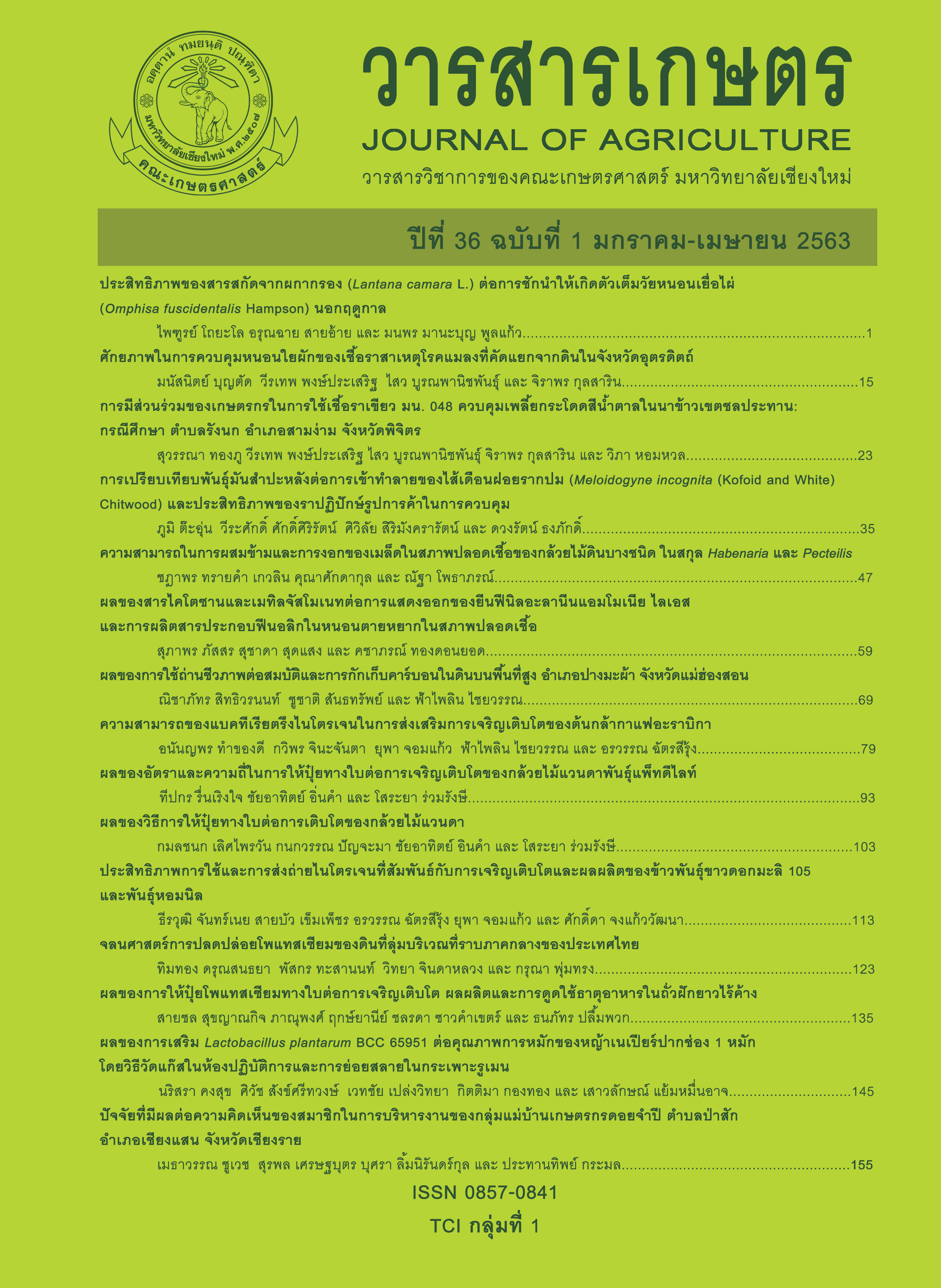Nitrogen Use Efficiency and Partitioning in Relation to Growth and Yield of Rice cv. Khao Dawk Mali 105 and cv. Homnil
Main Article Content
Abstract
Study of nitrogen use efficiency and partitioning in relationship to growth and yield of rice was performed using split plot design in which main plot was rice variety e.g. cv. Khao Dawk Mali 105 and cv. Homnil and sub plot was nitrogen application rates e.g. 0, 15 and 30 kgN/rai. The results showed that, when 15 kgN/rai was applied, the dry matter return of Khao Dawk Mali 105 was almost twice higher than that of Homnil (30.62 and 16.11 kgDM/kgN, respectively). However, at the rate of 30 kgN/rai, the dry matter return of the two rice varieties showed no significant difference. The agronomic efficiency of Homnil was slightly higher than that of Khao Dawk Mali 105 with the average values of 5.85 and 7.11 kg yield/kgN, respectively. The results of nitrogen partitioning (N dynamic) revealed that the nitrogen concentration in root, shoot and leaves of both Khao Dawk Mali 105 and Homnil showed a tendency to increase from tillering until dough stage. The nitrogen content in panicle was higher than those of leaves, stem and root with the maximum average values of 10.4, 7.3, 5.4 and 4.8 mgN/g DM, respectively. The higher rate of nitrogen application rate had no significant effect in promoting nitrogen content in the rice tissue. However, the dry matter of root, shoot, leaves and panicle was increased with the rate of nitrogen application indicating that the nitrogen concentration in rice tissues had no relationship with the rice yield. There was no significant difference in grain yield among Khao Dawk Mali 105 and Homnil. Average greatest grain yield was found at 30 kgN/rai with the value of 420.5 kg/rai.
Article Details
References
Chinda, M., S. Luangsirorat and S. Rurkviree. 1999. Influence of chemical and organic fertilizers on soil properties and yield of rice grown on Nakhon Prathom soil. Soil Science Division, Department of Agriculture, Bangkok. (in Thai)
Guindo, D., B.R. Wells and R.J. Norman. 1994. Cultivar and nitrogen rate influence on nitrogen uptake and partitioning in rice. Soil Science Society of America Journal 58(3): 840-845.
Guindo, D., B.R. Wells, C.E. Wilson and R.J. Norman. 1992. Seasonal accumulation and partitioning of nitrogen-15 in rice. Soil Science Society of America Journal 56(5): 1521-1527.
Khemthong, P., T. Mekhora and S. Kuhaswonvetch. 2014. Feasibility study of black jasmine rice (Hom Nil) production in Nongchok district, Bangkok. King Mongkut’s Agricultural Journal 32(3): 27-35. (in Thai)
Mae, T. 1986. Partition and utilization of nitrogen in rice plants. Japan Agricultural Research Quarterly 20(2): 115-120.
Mae, T. and K. Ohira. 1981. The remobilization of nitrogen related to leaf growth and senescence in rice plants (Oryza sativa L.). Plant and Cell Physiology 22(6): 1067-1074.
Mae, T. and S. Shoji. 1984. Studies on the fate of fertilizer nitrogen in rice plants and paddy soils by using 15N as a tracer in northeastern Japan. pp. 77-94. In: Soil Science and Plant Nutrition in Northeastern Japan (Special issue). Japan Society of Soil Science and Plant Nutrition, Sendai.
McKenzie, H.A. and H.S. Wallace. 1954. The Kjedahl determination of nitrogen: a critica study of digestion conditions-temperature, catalyst, and oxidizing agent. Australian Journal of Chemistry 7(1): 55-70.
Muhammad, S., U.J. Kim and K. Kumazawa. 1974. The uptake, distribution, and accumulation of 15N-labelled ammonium and nitrate nitrogen top-dressed at different growth stages of rice. Soil Science and Plant Nutrition 20(3): 279-286.
Nongsin, A. 1999. Accumulation and partitioning of nitrogen in rice as influenced by nitrogen application rates. M.S. Thesis. Chiang Mai University, Chiang Mai. 105 p. (in Thai)
Osotsapar, Y., A. Wongmaneeroj and C. Hongprayoon. 2008. Fertilizer for Sustainable Agriculture. Kasetsart University Press, Bangkok. 519 p. (in Thai)
Pundonfai, N. 2013. Nitrogen partitioning and its relationship to chlorophyll level in leaves of rice cv. Khao Dawk Mali 105. M.S. Thesis. Chiang Mai University, Chiang Mai. 94 p. (in Thai)
Punyakaew, T. 1999. Response of rice cv. KDML 105 to nitrogen fertilizer under minimum tillage. M.S. Thesis. Chiang Mai University, Chiang Mai. 43 p. (in Thai)
Rice Department. 2017. Homnil rice. (Online). Available: https://www.thairicedb.com/rice-detail.php?id=16 (December 12, 2018). (in Thai)
Sampet, C. 1999. Crop Physiology. Chiang Mai University, Chiang Mai. 284 p. (in Thai)
Slocum, R.D. 1991. Polyamine biosynthesis in plants. pp. 23-40. In: R.D. Slocum and H.E. Flores (eds.). Biochemistry and Physiology of Polyamines in Plants. CRC Press, London.
Thanananta, N, V. Prasit and T. Thanananta. 2012. Identification of rice cultivars KDML 105 and its improved cultivars by using HAT-RAPD technique. Thai Journal of Science and Technology 1(3): 169-179. (in Thai)
Tirol-Padre, A., J.K. Ladha, U. Singh, E. Laureles, G. Punzalan and S. Akita. 1996. Grain yield performance of rice genotypes at suboptimal levels of soil N as affected by N uptake and utilization efficiency. Field Crops Research 46(1-3): 127-143.
Wang, D., C. Xu, C. Ye, S. Chen, G. Chu and X. Zhang. 2018. Low recovery efficiency of basal fertilizer-N in plants does not indicate high basal fertilizer-N loss from split-applied N in transplanted rice. Field Crops Research 229: 8-16.
Yoshida, S. 1981. Fundamentals of Rice Crop Science. International Rice Research Institute, Los Baños. 260 p.


